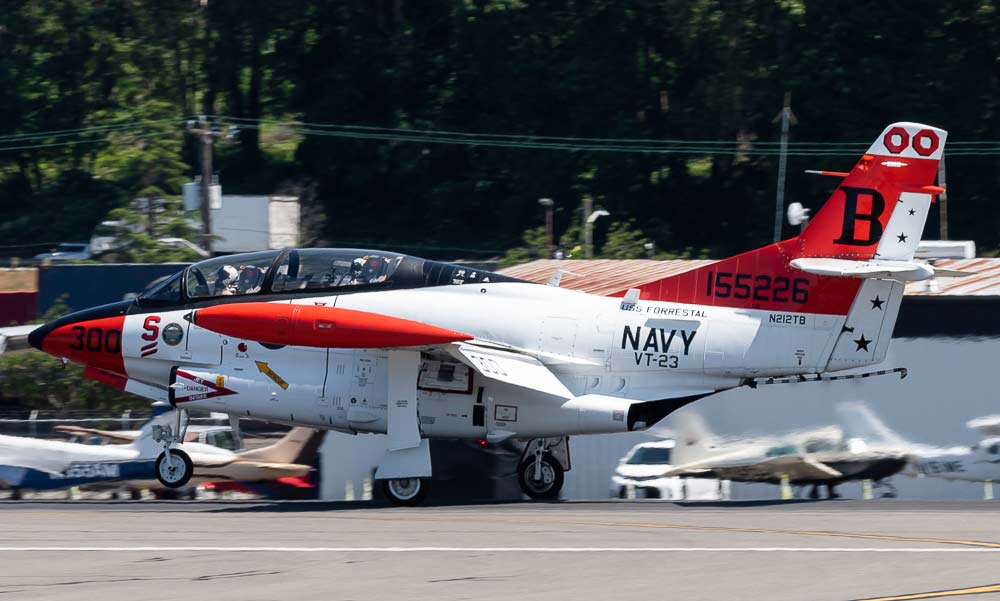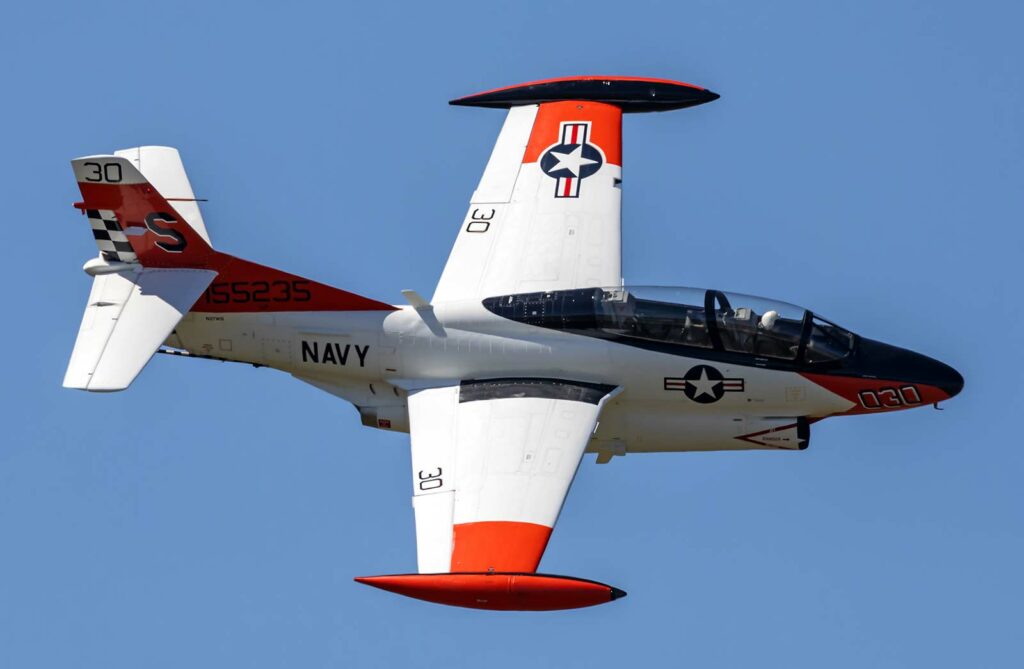The T-2 Buckeye, a versatile US Navy jet trainer, served for decades in pilot and navigator training with tandem seating and dual engines.
In brief
The North American / Boeing T-2 Buckeye was a naval jet trainer aircraft designed and built for the United States Navy for intermediate and advanced pilot training. Introduced in the late 1950s, the T-2 Buckeye was a critical component in preparing generations of naval aviators for carrier operations and combat flight. Featuring a straight-wing design, tandem seating for instructor and student, and initially powered by a single Westinghouse J34-WE-46/48 turbojet, later versions were upgraded to dual General Electric J85 engines to improve performance. The Buckeye was known for its reliability, ease of maintenance, and forgiving flight characteristics, making it an ideal training platform. With over 400 units produced, it served primarily in training roles, including carrier landing practice, weapons training, and basic jet flight introduction, until its retirement in the early 21st century.

History of the Development of the North American / Boeing T-2 Buckeye
The North American / Boeing T-2 Buckeye’s development story begins in the 1950s, an era marked by rapid advancements in jet technology and the increasing complexity of naval aviation operations. The U.S. Navy sought a new, dedicated training aircraft capable of preparing pilots for the demands of flying modern jet fighters and bombers from aircraft carriers. The objective was to create an aircraft that could provide both basic and advanced training, from fundamental flying skills to carrier operations and tactical maneuvers.
North American Aviation, which would later become part of Boeing, was awarded the contract to develop this new trainer. The program was initiated to replace older piston-engined trainers that were becoming obsolete in the jet age. The T-2 Buckeye first took to the skies on January 31, 1958, quickly proving itself as an effective and versatile training tool.
The aircraft was named “Buckeye” after the state tree of Ohio, reflecting the location of the North American Aviation’s principal manufacturing facilities and symbolizing the robust and dependable nature of the aircraft.
Design of the North American / Boeing T-2 Buckeye
The T-2 Buckeye’s design focused on simplicity, reliability, and the versatility required for a broad range of training missions. Measuring approximately 38 feet in length with a wingspan of 38.1 feet, the aircraft featured a straight-wing configuration that provided stability and ease of handling, crucial for training purposes. Its initial powerplant, the Westinghouse J34 turbojet, was later upgraded in subsequent models to two General Electric J85 turbojets, enhancing its performance and safety with a twin-engine configuration.
The dual tandem seating allowed for an instructor and a student to be accommodated, with the student pilot in the front and the instructor in the raised rear seat, ensuring both had excellent visibility. The cockpit was equipped with instrumentation and controls that mirrored those of operational Navy jet fighters, facilitating a smooth transition for trainees to more advanced aircraft.
One of the significant advantages of the T-2 Buckeye was its adaptability to carrier operations training, thanks to its robust landing gear, arresting hook, and capability to operate from short runways, simulating the conditions of aircraft carrier decks. However, its straightforward design meant that it lacked the high-speed performance and advanced avionics of frontline combat aircraft, focusing instead on the fundamentals of flight training.
Performance of the North American / Boeing T-2 Buckeye
The performance characteristics of the T-2 Buckeye were tailored to its training mission. With its dual General Electric J85-GE-4 turbojets in later versions, the aircraft could reach speeds up to 520 mph (837 km/h), with a range of approximately 1,000 miles (1,609 kilometers) and a service ceiling of 44,400 feet (13,533 meters). These figures provided a broad envelope for training scenarios, from basic flight operations to advanced tactical maneuvers.
While not designed for combat, the Buckeye’s performance was sufficient to simulate the flight characteristics and operational procedures of carrier-based jets, such as takeoffs and landings, aerobatics, and basic air combat maneuvers. Its straightforward, reliable performance made it less about competing with frontline fighters in terms of speed and agility, and more about providing a stable, effective platform for the comprehensive training of naval aviators.
Variants of the North American / Boeing T-2 Buckeye
The T-2 Buckeye saw several variants throughout its service life, each designed to improve upon the capabilities of its predecessors. The initial T-2A model was followed by the T-2B, which featured upgraded engines for better performance. The T-2C, the most widely used variant, introduced the dual General Electric J85 engines, significantly enhancing its speed, range, and reliability. The T-2D and T-2E were export versions, tailored to the specific needs of foreign military customers. Each variant maintained the core attributes of the Buckeye while incorporating improvements to meet evolving training requirements.

Military Use and Combat of the North American / Boeing T-2 Buckeye
Primarily used as a trainer, the T-2 Buckeye was not designed for combat roles. However, its military use was extensive in the context of training missions, preparing countless naval aviators for carrier-based operations and combat missions in more advanced aircraft. The Buckeye’s armament capabilities were limited, usually restricted to training ordnance for weapons delivery practice.
The T-2 served with distinction in the U.S. Navy and Marine Corps, as well as in the air forces of other countries, including Greece and Venezuela. It played a crucial role in the Cold War era and beyond, ensuring pilots were adept in the skills required for modern aerial warfare. Although it has been retired from active service in the U.S. Navy, replaced by the T-45 Goshawk, some countries continue to use the Buckeye for training purposes.
The North American / Boeing T-2 Buckeye embodied the essential qualities of an effective military trainer aircraft. Its design prioritized the needs of training naval aviators, providing them with a platform that was reliable, versatile, and capable of simulating the flight conditions of carrier-based operations. Throughout its decades of service, the Buckeye played a pivotal role in shaping competent, skilled pilots ready to transition to the more demanding environments of combat aircraft. Its legacy as a foundational element of naval aviation training endures, reflecting the enduring importance of well-designed training aircraft in military readiness and effectiveness.
Back to the Trainers section.